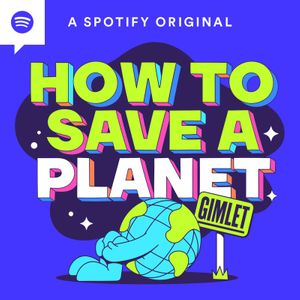The Beef with Beef
How to Save a Planet - Ein Podcast von Gimlet

Kategorien:
A quarter of global greenhouse gas emissions come from agriculture and land use – and a big portion of those emissions come from producing meat. Adopting a plant-based diet is one of the biggest steps an individual can take to reduce their own carbon footprint. So, should we all stop eating meat? Or is it more complicated than that? This week, we take a tour through the bodily functions of cows, millions of acres of corn, and the hidden policy that shapes the American food system to answer that question once and for all. Guests: Marco Springmann, Tom Philpott and Matthew Hayek Calls to Action Sign up to track the latest U.S. Food & Agriculture bills, and contact Agriculture Committee members (House and Senate) about supporting a climate-friendly Farm Bill. Contact the places you eat regularly about providing beef-less options – maybe it’s the cafeteria at work or school, or a community gathering space. Meatless Monday has resources for institutions that want to provide more climate-friendly meals. Get involved with a local organization fighting food insecurity, a mutual aid group, a community garden, or a co-op. We also talk about mutual aid in our Unnatural Disasters episode! Learn More Read the World Resources Institute’s report on Creating a Sustainable Food Future. Read this study about regenerative methods in beef production. Read this study about red seaweed reducing methane in beef production. Check out this data visualization on land use in the U.S. Listen to the Science Vs. episode on vegan diets. Check out our Calls to Action archive here for all of the actions we've recommended on the show. Send us your ideas or feedback with our Listener Mail Form. Sign up for our newsletter here. And follow us on Twitter and Instagram. This episode of How to Save a Planet was produced by Anna Ladd. The rest of our reporting and producing team includes Kendra Pierre-Louis, Rachel Waldholz and Felix Poon. Our intern is Ayo Oti. Our senior producer is Lauren Silverman. Our editor is Caitlin Kenney. Sound design and mixing by Peter Leonard with original music from Emma Munger. Update 4/13/21 An earlier version of this episode incorrectly said that the regenerative practices described by researcher Paige Stanley require more than twice as much land as we already use for grazing. While it is true that this regenerative grazing method requires more land to produce the same amount of beef that is conventionally grazed and later fed at a feedlot, there is a trade off – regenerative grazing would result in more healthy soil that sequesters carbon, and less cropland growing corn that releases it. The episode has been updated. Learn more about your ad choices. Visit podcastchoices.com/adchoices
